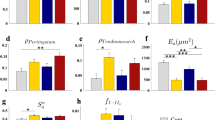Summary
The author compares the degree of extension of the isolated symmetrical muscles of rabbits, one of the extremities of which was subjected to immobilization in the position of flexion or extension for the period of 1–5 months. Immobilization causes the decrease in the stretching capacity in muscles of the fixated extremity, as compared to control. This difference was greater in cases of fixation in a position of extension. In prolonged periods of immobilization the changes were noted in the stretching extension capacity of the control extremity, i. e. an increase in the stretching capacity in fixation in the position of extension and its decrease in the position of flexion. The degree of these changes was also found to be greater in fixation in the position of extension, i. e. in the position less “physiological” for rabbits.
Similar content being viewed by others
Literature Cited
A. V. Zhirmunskii, Changes in the Substance and Function of the Skeletal Muscles After Denervation.
O. V. Nedrigailova, Uch. Zap. Ukrain. nauchno-issled. in-la ortopedii travmalologii, 53–75, Khar'kov (1948).
S. I. Frankshtein Khirurgiia 8, 44–47 (1944).
H. Chor and R. E. Dolkart, Am. J. Physiol. v. 117, 626–630 (1936).
Author information
Authors and Affiliations
Rights and permissions
About this article
Cite this article
Chetverikova, G.A. Changes in the visco-elastic properties of muscles in contractures after immobilization. Bull Exp Biol Med 46, 1322–1326 (1958). https://doi.org/10.1007/BF00845173
Received:
Issue Date:
DOI: https://doi.org/10.1007/BF00845173




